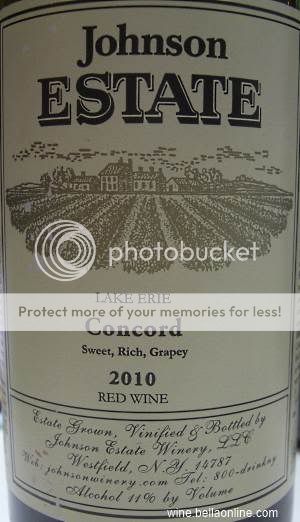Concord wine

I had a glass of Concord wine last month at the London International Wine Fair. It wasn’t the first Concord I had tasted, but the first since I was last in New England a couple of years ago. Concord isn’t often seen outside north eastern USA and Washington state, although an exception is Kosher wines, of which a long established major producer is in New York City.

You don’t read reviews of Concord from major critics and most wine aficionados dismiss it out of hand. Yet it has enthusiastic drinkers in its local area.
Concord is a native American grape variety; it is not part of the vitis vinifera family that produce the world’s fine wines but an American branch of vitis called Labrusca which have a distinctive taste known as ‘foxy’.
Concord takes its name from the city in Massachusetts where it was selected from one of 2,000 seedlings planted by Ephraim Bull in 1843.
The Concord wine I tasted was sweet, very jammily fruity and deeply purple. Although it wasn’t sparkling it reminded me of a fizzy drink, like a cross between cola and Dr. Pepper. I could see why it was a wine attractive to new drinkers.
But there is more to its attraction. While its flavour is a surprise to Europeans, Americans are brought up on Concord. Children’s cough medicines and candies are sweetened by Concord juice and non-alcoholic Concord grape juice is popular. The Welch fruit juice company first produced Concord grape juice in 1869. And small packets of Concord grape jelly are found on the tables of US diners to spread on breakfast toast.
Concord grows well in the severe conditions of northern USA and is immune to many of the diseases that damage other vines but because it is not vinifera that means it cannot make wine on its own. The grapes do not have enough sugar for fermentation and they are too acidic, so sugar must be added and the acidic juice diluted with water. The ‘foxy’ taste can be partly hidden by making the wine very sweet.
The wine I tasted was grown and made by New York’s oldest estate winery, the family owned Johnson Estate on the banks of Lake Erie at Westfield. The Johnsons have been growing grapes for more than one hundred years and they started making their own wine on the farm in 1961. See www.johnsonwinery.com.
The Johnsons recommend chilling the wine and enjoying it with desserts or pouring over ice for drinking on its own. The wine has low alcohol at 11% abv, and 10% residual sugar.
Have you tasted Concord wine? Tell us what you thought on our forum.

You don’t read reviews of Concord from major critics and most wine aficionados dismiss it out of hand. Yet it has enthusiastic drinkers in its local area.
Concord is a native American grape variety; it is not part of the vitis vinifera family that produce the world’s fine wines but an American branch of vitis called Labrusca which have a distinctive taste known as ‘foxy’.
Concord takes its name from the city in Massachusetts where it was selected from one of 2,000 seedlings planted by Ephraim Bull in 1843.
The Concord wine I tasted was sweet, very jammily fruity and deeply purple. Although it wasn’t sparkling it reminded me of a fizzy drink, like a cross between cola and Dr. Pepper. I could see why it was a wine attractive to new drinkers.
But there is more to its attraction. While its flavour is a surprise to Europeans, Americans are brought up on Concord. Children’s cough medicines and candies are sweetened by Concord juice and non-alcoholic Concord grape juice is popular. The Welch fruit juice company first produced Concord grape juice in 1869. And small packets of Concord grape jelly are found on the tables of US diners to spread on breakfast toast.
Concord grows well in the severe conditions of northern USA and is immune to many of the diseases that damage other vines but because it is not vinifera that means it cannot make wine on its own. The grapes do not have enough sugar for fermentation and they are too acidic, so sugar must be added and the acidic juice diluted with water. The ‘foxy’ taste can be partly hidden by making the wine very sweet.
The wine I tasted was grown and made by New York’s oldest estate winery, the family owned Johnson Estate on the banks of Lake Erie at Westfield. The Johnsons have been growing grapes for more than one hundred years and they started making their own wine on the farm in 1961. See www.johnsonwinery.com.
The Johnsons recommend chilling the wine and enjoying it with desserts or pouring over ice for drinking on its own. The wine has low alcohol at 11% abv, and 10% residual sugar.
Have you tasted Concord wine? Tell us what you thought on our forum.
Peter F May is the author of Marilyn Merlot and the Naked Grape: Odd Wines from Around the World which features more than 100 wine labels and the stories behind them, and PINOTAGE: Behind the Legends of South Africa’s Own Wine which tells the story behind the Pinotage wine and grape, also available for the Kindle. |

Related Articles
Editor's Picks Articles
Top Ten Articles
Previous Features
Site Map
Content copyright © 2023 by Peter F May. All rights reserved.
This content was written by Peter F May. If you wish to use this content in any manner, you need written permission. Contact Peter F May for details.


